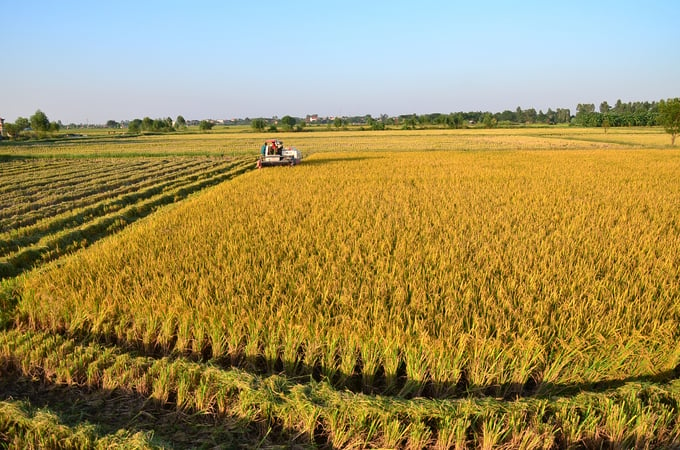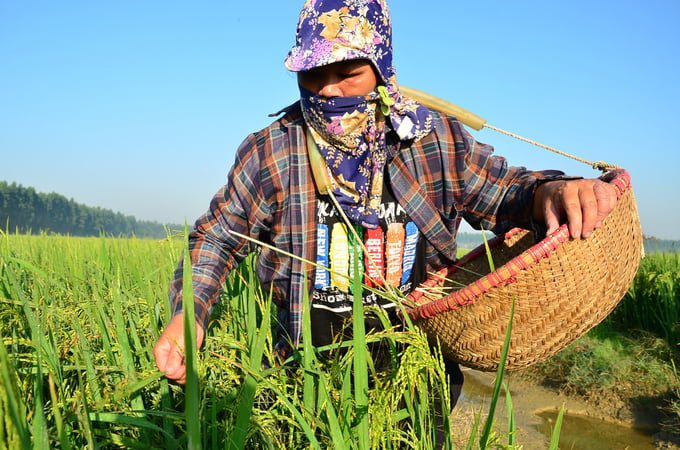June 19, 2025 | 01:21 GMT +7
June 19, 2025 | 01:21 GMT +7
Hotline: 0913.378.918
June 19, 2025 | 01:21 GMT +7
Hotline: 0913.378.918
For 7 years she mourned and wept in silence, then her husband “came back from the dead” as he was only caught by the enemy. And so she “came back to life”, only to work alone on the 2.2 mau of field (1 mau equals 10 sao, which is 3600 m2) of the big family with 11 mouths to feed. She is Nguyen Thi Cham from Pham Xa village, Ngo Quyen commune, Thanh Mien district, Hai Duong province.
In 2010 Lam Son commune (Thanh Mien district) had this movement of people applying to return their field. It was not like that in her hometown, but it was true that many people began to get bored of the field. First they rented the field, then they even allow people to lend it. She could not bear to witness those fields going to waste, so she took up the offers and planted a total of 30 mau.
After seeing that she earned profits by planting big fields, the farmers asked to take their land back, so the area was reduced to 25 mau. At that time, the husband grew weaker with each passing day due to the wounds accumulated after years of imprisonment and torture. For 6 years and 7 months, he was unable to speak, lying in one place. Cham was on her own, taking care of food, bathing, and farming until the day her husband left the temporary world.

Cham’s vast field. Photo: Duong Dinh Tuong.
Although she works in the field, the 71-year-old woman considers herself “a white-legged farmer”, who no longer needs to wade in the mud, but just sits on the bank to manage and direct the work. How many laborers are needed to plant, fertilize, and spray pesticide each day, she just assigns, and then they will work diligently.
“I am getting older every day, but technology is getting more and more modern, so even 100 mau is still a piece of cake. Spraying pesticides using a shoulder-hold bottle is the story of the past, now the drone can spray my 25 mau of field in less than 8 hours. In the past, 25 mau required 20 people to reap in 10 sessions, but now it takes less than 2 days to harvest. The cooperative warehouse yard used to be the place to dry rice, 4 workers can only dry 5 tons in 2 sessions, but now 25 mau of rice can be harvested fresh and weighed right on the spot,” Cham said.

Mrs. Cham (far right) taking note of the amount of rice harvested. Photo: Duong Dinh Tuong.
Despite having a high rice yield, the price of rice was poor last year, Cham earned a modest profit of approximately VND 100 million. This year's spring crop was compensated with favorable weather and a good price of VND 8,200/kg. No matter how much she produced, it was still considered lacking as traders had to compete with each other to buy. She gave priority to brothers in the family to sell and dry, and outsiders got rejected even if they offer to pay a higher price. Cham collected a hefty VND 420 million while spending only VND 280 million, making a net profit of VND 140 million in that crop alone.
"Agricultural extension knight" Vu Van Tien - former Head of Thanh Mien Agricultural Extension Station, who directly gave Cham free technical advice, said, "Ms. Cham is one of the district’s pioneer farmers in cultivating on a large area and having absolute trust in technical staff. She has wits in organizing production, decisiveness, and good management. Employees can never get pass her with their ‘tricks’.
“Not only that, she often learns about the market to understand its "flow" and then has dry rice reserves ready while waiting until the price is high to sell to earn as much profit as possible. Working hard to pick up every penny, but she is still willing to do charity for those in difficult circumstances, generously giving to associations and unions instead of just focusing on her own livelihood.”
Tran Xuan Ai - Pham Thi Thin, husband and wife in Tieu Lam village, Ngu Hung commune, Thanh Mien district, Hai Duong province, started their journey of large-scale production in 2014. After their locality gathered and changed plots, they swapped and borrowed fields to gather a 15-mau field. More and more people left the field so they were able to borrow land from more than 100 families, plus rent 30 mau of public land from the cooperative for a fee of 30-45 kg of rice/sao/year. The total area went up to 140-150 mau. In order to take care of this vast area of field, they bought 2 harvesters, 2 plows, and 1 dryer with a 20 tons/batch capacity.
Unlike many people in the locality, Thin and her husband only choose Q5 "pig rice" rice for transplanting: "Q5 is specialized rice for raising pigs, cooking wine, and making rice paper. The solid stalk makes the plant hard to fall, so it's very convenient for scattered sowing. The yield is quite stable at 250 kg/sao in the spring crop and 200 kg/sao in the seasonal crop. There will always be many buyers no matter how we sell. My family sells an average of 350-400 tons of rice each crop, never afraid of not having any customers. Even when we sell our rice cheaply, it is at least VND 7,000/kg. The average profit from the spring crop is over VND 300 million. As for the seasonal crop, the profit normally exceeds VND 200 million.”

Thin going around the field to pick up “ghost rice” (wild rice that affects the field’s overall productivity). Photo: Duong Dinh Tuong.
But rice farming is never easy. There are years when wind, pest and disease destroyed the field like this recent crop, ghost rice appeared quite a lot but the couple had no effective solution for it. Thin said, “Usually during the transplanting stage, I hire 20 people to sow, and hire some more when it’s time to harvest and pack the rice. The rest of the time, it's just us doing all the work. Apart from the two rice crops, we also do one winter crop, growing an average of 40 mau of cabbage, and earning a profit of VND 100-150 million, sometimes VND 200-300 million. But there were years like during Covid when the product couldn't sell well, we had to cut down thousands of tons of cabbage and laid it into the field to make manure. I really just wanted to cry my eyes out back then.”
I went to the Sanh paddy field where the couple is planting 50 mau of rice. The scene in front of my eyes was as beautiful as a picture. The rice plant, bathed in the sunlight, turned golden. Seeing me immersing myself in the beauty of the soon-to-be-harvested rice field, Thin gave a bright smile and said, "When I see the beautiful rice, I smile, but when I see the bad rice, I am afraid that the villagers might laugh at me for it! I’m planning to invest in drones to spray pesticides on my fields and provide services to my neighbors. I just hope that households would sign contracts to lend or lease long-term fields until the government takes them out, so I can feel assured with my investment."
Translated by Samuel Pham
![Turning wind and rain into action: [9] Digitizing hydrometeorological data in response to climate change](https://t.ex-cdn.com/nongnghiepmoitruong.vn/608w/files/news/2025/06/17/z6704423696987_15fd32ffc26d590d204d520c9dac6786-nongnghiep-165943.jpg)
(VAN) Farmers have begun accessing hydrometeorological applications to adjust their cropping schedules, aiming to ensure productivity and adapt to climate change.
![Turning wind and rain into action: [8] Real-time salinity detection and early warning technology](https://t.ex-cdn.com/nongnghiepmoitruong.vn/608w/files/news/2025/06/17/z6704423696987_15fd32ffc26d590d204d520c9dac6786-nongnghiep-151127.jpg)
(VAN) Thanks to the integration of modern hydrological-hydraulic models, remote sensing technologies, and artificial intelligence, the accuracy of hydrological forecasting has significantly improved.
![Turning wind and rain into action: [7] Early disaster warnings help marine farmers minimize losses](https://t.ex-cdn.com/nongnghiepmoitruong.vn/608w/files/news/2025/06/17/z6704423696987_15fd32ffc26d590d204d520c9dac6786-nongnghiep-142942.jpg)
(VAN) In recent years, thanks to early disaster warnings and forecasting, marine farmers in Khanh Hoa province have been able to reduce risks and losses, thereby improving production efficiency.
![Turning wind and rain into action: [6] ‘Four on-the-spot’ disaster management software](https://t.ex-cdn.com/nongnghiepmoitruong.vn/608w/files/news/2025/06/17/e5a48259d6a262fc3bb3-nongnghiep-183800.jpg)
(VAN) By simply activating the scenario on the disaster management software, the relevant authorities immediately know how many households need to be evacuated, where to evacuate them to, and by what means of transportation…
![Turning wind and rain into action: [5] Hue applies modern technology in disaster forecasting](https://t.ex-cdn.com/nongnghiepmoitruong.vn/608w/files/news/2025/06/17/z6704423696987_15fd32ffc26d590d204d520c9dac6786-nongnghiep-093938.jpg)
(VAN) In Hue city, modern technology has recently been applied in meteorological and hydrological forecasting and warning, helping to reduce the damage caused by natural disasters.

(VAN) A cutting-edge farming technique being implemented on an experimental ranch in Arizona's Sonoran Desert has already saved a billion gallons of water over five years, according to Civil Eats.

(VAN) Poultry and pig production and the environment can be boosted through enhanced water technology, according to new research.